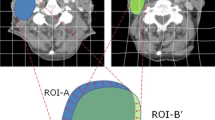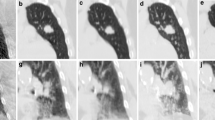Abstract
Purpose
This observer study aimed to compare rigid image registration (RIR) with deformable image registration (DIR) for diagnostic position (DP) positron emission tomography/computed tomography (PET/CT) images in the delineation of gross tumor volumes (GTVs) in nasopharyngeal carcinoma (NPC) radiotherapy planning.
Materials and methods
Four radiation oncologists individually delineated the GTVs, GTVRIR, and GTVDIR, on planning CT (pCT) images registered with DP-PET/CT images using RIR and B-spline-based DIR, respectively. Reference GTVs were independently delineated by all radiation oncologists using radiotherapy position (RP)-PET/CT images. DP- and RP-PET/CT images for 14 patients with NPC were acquired using early and delayed scans, respectively. Dice’s similarity coefficient (DSC), mean distance to agreement, and volume agreement with reference GTVs were compared by considering the interobserver variability in reference contours.
Results
The average DSCs for GTVRIR and GTVDIR were 0.77 and 0.77, which were acceptable for GTV delineation. There were no statistically significant differences between GTVRIR and GTVDIR in all evaluation indexes (p > 0.05). Furthermore, the correlation between neck flexion angle differences and GTV accuracy was not statistically significant (p > 0.05).
Conclusion
RIR was a feasible choice compared with the B-spline-based DIR in GTV delineation for NPC under variations of neck flexion angle.





Similar content being viewed by others
References
Wei WI, Sham JS. Nasopharyngeal carcinoma. Lancet. 2005;365:2041–54.
Toya R, Murakami R, Saito T, Murakami D, Matsuyama T, Baba Y, et al. Radiation therapy for nasopharyngeal carcinoma: the predictive value of interim survival assessment. J Radiat Res. 2016;57:541–7.
Nutting C, Gujral D. Head and neck cancer. In: Hoskin P, editor. External beam therapy. 3rd ed. Oxford: Oxford University Press; 2019. p. 405–437.
Delikgoz Soykut E, Ozsahin EM, Yukselen Guney Y, Aytac Arslan S, Derinalp Or O, Altundag MB, et al. The use of PET/CT in radiotherapy planning: contribution of deformable registration. Front Oncol. 2013;3:33.
Mohandas A, Marcus C, Kang H, Truong MT, Subramaniam RM. FDG PET/CT in the management of nasopharyngeal carcinoma. AJR Am J Roentgenol. 2014;203:W146–W157157.
Koshy M, Paulino AC, Howell R, Schuster D, Halkar R, Davis LW. F-18 FDG PET-CT fusion in radiotherapy treatment planning for head and neck cancer. Head Neck. 2005;27:494–502.
Nestle U, Kremp S, Grosu AL. Practical integration of [18F]-FDG-PET and PET-CT in the planning of radiotherapy for non-small cell lung cancer (NSCLC): the technical basis, ICRU-target volumes, problems, perspectives. Radiother Oncol. 2006;81:209–25.
Tejwani A, Lavaf A, Parikh K, Mokhtar B, Swamy U, Emmolo J, et al. The role of PET/CT in decreasing inter-observer variability in treatment planning and evaluation of response for cervical cancer. Am J Nucl Med Mol Imaging. 2012;2:307–13.
Oh S, Kim S. Deformable image registration in radiation therapy. Radiat Oncol J. 2017;35:101–11.
Hwang AB, Bacharach SL, Yom SS, Weinberg VK, Quivey JM, Franc BL, et al. Can positron emission tomography (PET) or PET/computed tomography (CT) acquired in a nontreatment position be accurately registered to a head-and-neck radiotherapy planning CT? Int J Radiat Oncol Biol Phys. 2009;73:578–84.
Ireland RH, Dyker KE, Barber DC, Wood SM, Hanney MB, Tindale WB, et al. Nonrigid image registration for head and neck cancer radiotherapy treatment planning with PET/CT. Int J Radiat Oncol Biol Phys. 2007;68:952–7.
Kovalchuk N, Jalisi S, Subramaniam RM, Truong MT. Deformable registration of preoperative PET/CT with postoperative radiation therapy planning CT in head and neck cancer. Radiographics. 2012;32:1329–41.
Fortin D, Basran PS, Berrang T, Peterson D, Wai ES. Deformable versus rigid registration of PET/CT images for radiation treatment planning of head and neck and lung cancer patients: a retrospective dosimetric comparison. Radiat Oncol. 2014;9:50.
Mohamed AS, Rosenthal DI, Awan MJ, Garden AS, Kocak-Uzel E, Belal AM, et al. Methodology for analysis and reporting patterns of failure in the Era of IMRT: head and neck cancer applications. Radiat Oncol. 2016;11:95.
Kadoya N, Kito S, Kurooka M, Saito M, Takemura A, Tohyama N, et al. Factual survey of the clinical use of deformable image registration software for radiotherapy in Japan. J Radiat Res. 2019;60:546–53.
Brock KK, Mutic S, McNutt TR, Li H, Kessler ML. Use of image registration and fusion algorithms and techniques in radiotherapy: report of the AAPM Radiation Therapy Committee Task Group No. 132. Med Phys. 2017;44:e43–e76.
Crum WR, Camara O, Hill DL. Generalized overlap measures for evaluation and validation in medical image analysis. IEEE Trans Med Imaging. 2006;25:1451–61.
Thomson D, Boylan C, Liptrot T, Aitkenhead A, Lee L, Yap B, et al. Evaluation of an automatic segmentation algorithm for definition of head and neck organs at risk. Radiat Oncol. 2014;9:173.
Kadoya N, Fujita Y, Katsuta Y, Dobashi S, Takeda K, Kishi K, et al. Evaluation of various deformable image registration algorithms for thoracic images. J Radiat Res. 2014;55:175–82.
Pukala J, Johnson PB, Shah AP, Langen KM, Bova FJ, Staton RJ, et al. Benchmarking of five commercial deformable image registration algorithms for head and neck patients. J Appl Clin Med Phys. 2016;17:25–40.
Murakami R, Uozumi H, Hirai T, Nishimura R, Katsuragawa S, Shiraishi S, et al. Impact of FDG-PET/CT fused imaging on tumor volume assessment of head-and-neck squamous cell carcinoma: intermethod and interobserver variations. Acta Radiol. 2008;49:693–9.
Nagami N, Arimura H, Soufi M, Ohishi M, Imaizumi T, Yamaguchi Y, et al. An approach for evaluation of delineation accuracy of GTV contours with considering interobserver variability in reference contours: impact of MAR on radiation treatment planning. Med Imaging Inf Sci. 2019;36:4–9.
Li J, Xiao Y. Application of FDG-PET/CT in radiation oncology. Front Oncol. 2013;3:80.
Gaede S, Olsthoorn J, Louie AV, Palma D, Yu E, Yaremko B, et al. An evaluation of an automated 4D-CT contour propagation tool to define an internal gross tumour volume for lung cancer radiotherapy. Radiother Oncol. 2011;101:322–8.
Jiang J, Wu H, Huang M, Wu Y, Wang Q, Zhao J, et al. Variability of gross tumor volume in nasopharyngeal carcinoma using 11C-choline and 18F-FDG PET/CT. PLoS ONE. 2015;10:e0131801.
Zhao L, Lu Z, Jiang J, Zhou Y, Wu Y, Feng Q. Automatic nasopharyngeal carcinoma segmentation using fully convolutional networks with auxiliary paths on dual-modality PET-CT images. J Digit Imaging. 2019;32:462–70.
Men K, Chen X, Zhang Y, Zhang T, Dai J, Yi J, et al. Deep deconvolutional neural network for target segmentation of nasopharyngeal cancer in planning computed tomography images. Front Oncol. 2017;7:315.
Kadoya N, Nakajima Y, Saito M, Miyabe Y, Kurooka M, Kito S, et al. Multi-institutional validation study of commercially available deformable image registration software for thoracic images. Int J Radiat Oncol Biol Phys. 2016;96:422–31.
Nie K, Pouliot J, Smith E, Chuang C. Performance variations among clinically available deformable image registration tools in adaptive radiotherapy—how should we evaluate and interpret the result? J Appl Clin Med Phys. 2016;17:328–40.
Funding
None.
Author information
Authors and Affiliations
Corresponding author
Ethics declarations
Conflict of interest
The authors declare that they have no competing interests.
Ethical statement
This study was approved by the institutional ethics review board of Kumamoto University Hospital.
Informed consent
Subjects’ informed consent was obtained.
Additional information
Publisher's Note
Springer Nature remains neutral with regard to jurisdictional claims in published maps and institutional affiliations.
About this article
Cite this article
Kai, Y., Arimura, H., Toya, R. et al. Comparison of rigid and deformable image registration for nasopharyngeal carcinoma radiotherapy planning with diagnostic position PET/CT. Jpn J Radiol 38, 256–264 (2020). https://doi.org/10.1007/s11604-019-00911-6
Received:
Accepted:
Published:
Issue Date:
DOI: https://doi.org/10.1007/s11604-019-00911-6




